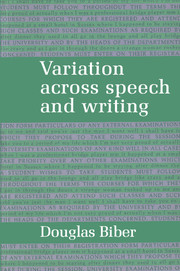Book contents
- Frontmatter
- Contents
- List of figures
- List of tables
- Acknowledgments
- Part I Background concepts and issues
- Part II Methodology
- Part III Dimensions and relations in English
- 6 Textual dimensions in speech and writing
- 7 Textual relations in speech and writing
- 8 Extending the description: variation within genres
- 9 Afterword: applying the model
- Appendix I Texts used in the study
- Appendix II Linguistic features: algorithms and functions
- Appendix III Mean frequency counts of all linguistic features in each genre
- Appendix IV Pearson correlation coefficients for all linguistic features
- References
- Index
7 - Textual relations in speech and writing
Published online by Cambridge University Press: 05 June 2012
- Frontmatter
- Contents
- List of figures
- List of tables
- Acknowledgments
- Part I Background concepts and issues
- Part II Methodology
- Part III Dimensions and relations in English
- 6 Textual dimensions in speech and writing
- 7 Textual relations in speech and writing
- 8 Extending the description: variation within genres
- 9 Afterword: applying the model
- Appendix I Texts used in the study
- Appendix II Linguistic features: algorithms and functions
- Appendix III Mean frequency counts of all linguistic features in each genre
- Appendix IV Pearson correlation coefficients for all linguistic features
- References
- Index
Summary
Factor scores and textual relations
The primary goal of this study is specification of the textual relations in English speech and writing, that is, the linguistic similarities and differences among English texts. To this point, six parameters of variation have been identified through a factor analysis and interpreted as underlying textual dimensions. In the present chapter, the similarities and differences among genres are considered with respect to each of these dimensions, and the overall relations among genres in speech and writing are specified by consideration of all dimensions simultaneously. Genres can be similar with respect to some dimensions but quite different with respect to others; the textual relations among genres are determined by the joint assessment of similarities and differences with respect to all dimensions.
Genres can be compared along each dimension by computing factor scores (see Section 5.5). To recapitulate, factor scores are computed by summing the frequency of each of the features on a factor, for each text; for example, the factor score of a text for Factor 2 might equal 23 past tense + 50 third person pronouns + 10 perfect aspect verbs + etc. The factor scores for each text can be averaged across all texts in a genre to compute a mean dimension score for the genre, and these mean dimension scores can be compared to specify the relations among genres.
- Type
- Chapter
- Information
- Variation across Speech and Writing , pp. 121 - 169Publisher: Cambridge University PressPrint publication year: 1988
- 1
- Cited by

